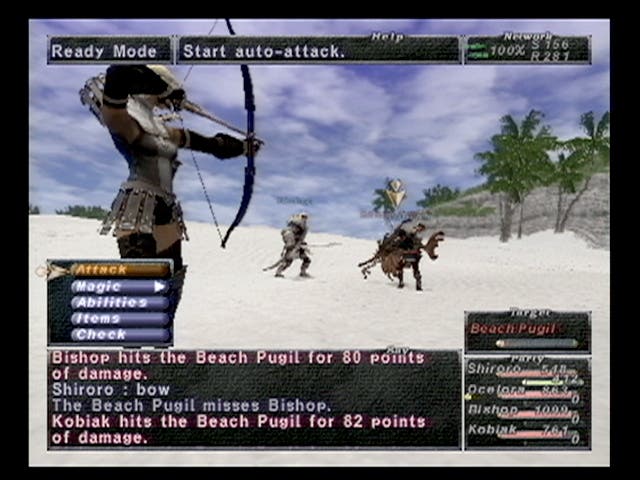PS3 Online: How It Works
Face to face with PlayStation 3's online capabilities.
The debate about online gaming is over. (Although the debate about whether one can be "face to face" with a capability will perhaps linger.) While we've spent the last five years - and longer, in some cases - talking about whether online functions were actually important to games, that discussion is now at an end. Online won, although perhaps not in the way that its most loyal adherents had hoped for. Every next-gen console, and even every recent handheld console, now sports an online service out of the box; networks are becoming a core element of what we could, if we were being a bit pretentious, call "the gaming ecosystem".
That doesn't, however, mean that all games have become online games. We haven't dispensed with single-player, and we never will - for many people, compelling experiences come from storytelling or cinematics, not from deathmatch or 40-man raiding parties. It's still hard to tell just how many people actually care about online gaming in terms of actually playing with other people, but it's certainly a fairly small, albeit growing, proportion of gamers. No, the real explosion in online has come from other areas - such as the ability to get game demos, to access new content for your games, to communicate with friends, to create an online identity for yourself and even to download entirely new games or retro titles over the network. Multiplayer gaming, as distinct from online gaming, is just a small part of what is now a much larger tapestry.
Unsurprisingly, the PC has been the pioneer in this area, just as it was the first platform to really adopt networked multiplayer gaming. You've been able to download demos, shareware games and indie software for years, and of course communicating with friends and creating an identity for yourself is core to the PC's online functionality. In the console arena, Microsoft leads the charge; the Xbox was the first games console to have a broadband, fully functional online service that gave users friends lists, notifications, voice chat and so on as a core part of the console, rather than as a strapped-on afterthought, and Xbox 360 builds on that to a massive degree with services like Xbox Live Marketplace and Xbox Live Arcade.
Sony, on the other hand, is late to the party. The PlayStation 2 didn't even have a built-in network port, let alone a network service as part of the core offering - and while isolated online titles like Final Fantasy XI proved massively popular on PS2 (in places where it was available, anyway), even the most die-hard Sony fan couldn't exactly describe the PS2's online service as a success. Certainly, it had more users than Xbox Live did last generation - but then again, the PS2 also had an installed base five times larger. In terms of ease of use, consistency of interface, and simple accessibility - not to mention software support - PS2 online was a distant second place to Xbox Live.
Third Time Lucky

Sony doesn't intend on allowing that to happen again - and despite Microsoft's five-year headstart in the online arena, the creators of PlayStation 3 are hoping that they can roll out an online service to rival Microsoft's for the launch of their console in Japan and North America in just a few scant weeks' time. A quick glance around the Internet suggests that skepticism regarding that particular goal is high - to say the least. Can a company whose online strategy in the last generation was so patchy, and their actual service so weak, really turn things around on the online front in time for the PS3's launch?
There's one way to tell for sure - actually look at the service in the flesh. For that, there's nowhere better to go than the office of Sony's worldwide studios boss Phil Harrison, located in Soho just near London's Oxford Street. Lots of Soho offices are pretty swish - but few of them have a fully functioning PlayStation 3 unit sitting under a massive HDTV screen, and hooked up to the test version of the PS3 online network which will switch over into a live service in early November when the console heads to store shelves in Japan and America.
First things first, and before we even touch the PS3, it's worth mentioning a few key factors which Sony is relying on heavily for the online service. For a start, the PS3 is designed from the ground up as an online device - unlike the PS2, which suffered from a number of major problems on that front. Building an online device requires a few major differences from an offline box - for one, it's important to be able to update your operating system, so that when you add new services or change features, you can incorporate those into the console's dashboard. On the Xbox or Xbox 360, new services are added with occasional software patches that are issued over Xbox Live; the PS2 couldn't do that, so you actually had to boot into a piece of software to do anything related to online functions. That's a clunky, messy way of doing things, and it's a big part of the reason why PS2 online was so poor.
PS3, however, has a fully upgradeable operating system, which is capable of downloading patches over the network and applying them to itself. This actually isn't new territory for Sony - the PlayStation Portable does exactly the same thing, and since that device was launched, Sony has added loads of new online features using network updates, including a fully functional web browser with Flash and RSS support. Actually, the comparisons with PSP don't stop there - we'll come back to those in a moment.
The other big difference on PS3 is that the device has a hard drive - even in its lower-spec configuration. This means that unlike the PS2, which relied on small, expensive memory cards that could easily be moved from machine to machine or even lost entirely, the console has the ability to store its configuration properly and reliably - not to mention being able to download and store loads of content. You couldn't have done that on PS2, which crippled the system from an online point of view.
Softly, Softly

Okay, so Sony is getting it right on the hardware front this time. Let's not beat around the bush, though - hardware is only a small part of the battle. Online services live or die on the strength of their software. Can I set up an account easily? Can I add and manage friends without a doctorate in computer science? How about buying content, or browsing for demos?
Let's turn the console on and find out.
Booting up a PS3 immediately reminds you of the PSP once again, because you're presented with the Cross Media Bar - that row of category icons across the middle of the screen which expand out vertically to reveal a number of new options as you hover over them. In fact, PSP users will be right at home on the PS3, since Sony's drive to ensure that it's presenting a consistent interface to users of its products means that you'll even see exactly the same icons for the same functionality. Settings, Photo, Music, Video, Game... These are all familiar from the PlayStation Portable, and although each one of them undoubtedly sports additional functions here, that's not what we're here for.
No, we're really here for the new buttons on the bar. On the far left, the first thing you highlight when you log in is called User Profiles. On the far right, you've got two buttons called Network (which appeared on the PSP in a firmware update) and Friends. User Profiles looks like a little house with a smiling face on it; Network is a globe; Friends is two little houses with smiling faces sort of touching, in a platonic way. They're friends, you see. Friendly houses.
User Profiles works pretty much how you would expect it to, with a list of the different profiles stored on the console popping up in the vertical bar when this option is highlighted. Yes, this is old hat if you're an Xbox 360 user, but the PS3 will support multiple user profiles on the console - so when you turn it on, you select your own profile, and you're instantly logged into your own PlayStation Network account as well as activating all your own settings for the system. If you share a console with multiple different people, or if friends come around to play often, this is an incredibly useful feature.
Moving one left, we can make a brief stop off at Settings if you like - here, you'll find the settings page for your network, allowing you to enter exciting things like IP addresses and passwords for wireless access, using pretty much exactly the same interface as the PSP. As with other consoles (and, realistically, the majority of network devices these days), the chances are you'll never really need to tweak anything in here, as your home network probably allows devices to auto-configure themselves using DHCP. Obviously enough, the PS3 stores its settings permanently, so you won't have to re-enter them for different games or any such guff.
The One With The Single Sign-In ID

Okay, let's scoot across the bar to the right hand side. One in from the right you find the Network button; this, essentially, is the web browser on the console. Unlike the Xbox 360, PS3 has a fully functional web browser, which according to Harrison supports a wide variety of standards right up to the complex Web 2.0 stuff you find places like Gmail using - and you can access any site on the Internet through the browser. So yes, you'll be able to browse Eurogamer on your PS3; now there's a killer app for you. Much like the PSP browser, this one will also support stuff like bookmarks and all the other usual features you'd expect from a web browser.
We're now teetering on the very right hand edge of the Cross Media Bar, looking at the Friends icon. This is where the magic happens... Is what I'd probably say, if I were working in a circus.
On the Friends vertical bar, there are two different types of icon. The first, logically enough, are friends - each of your signed-in friends has their own icon on this bar, and you select that icon to view a number of different ways of interacting with them. The other icons are those for managing your PlayStation Network account. Let's talk about those first.
At heart, there are two types of PlayStation Network account - a master account, and an associated account. The chances are that most gamers will use master accounts, but associated accounts will be especially useful for families - where, for example, a parent (who holds a master account) wants to be able to limit the amount that their kids (with associated accounts) can spend in the PlayStation Store.

